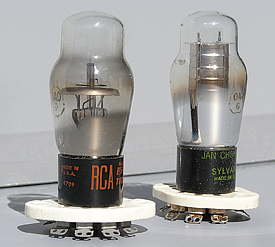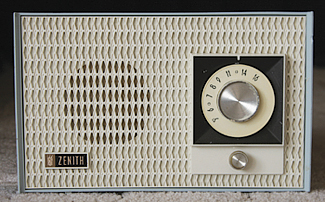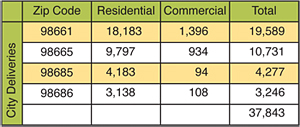An Emergency Alert System for the Digital Era

Fig. 1: RCA relay tubePrelude: Before World War II began, it was clear that some sort of Emergency Alarm System involving radio would be needed soon. RCA responded by developing a special purpose radio tube, its 0A4-G, a gas-filled Thyratron with a cold cathode for extremely long life and requiring no standby power at all. This tube could detect an unmodulated RF carrier (which would be impressed on the power lines) to activate a relay that would then supply power to a radio receiver, bypassing its power switch. This was an example of carrier current transmission, already widely used on university campuses to provide a radio service to students living near the campus. This particular application of carrier current technology would be used to alert the public in the event of an air raid, should hostilities spill over from Europe into the United States.
RCA Tube Handbook HB-3, in Volume No. 1 for the 0A4-G shows the circuit on a data sheet dated April 20, 1938. RCA Receiving Tube Manuals up to and including RC-14 say of the OA4-G: "Because the discharge can be initiated with so little (RF) energy it is practical to obtain remote control of line-operated electrical devices by means of an electrical impulse generated at radio frequencies and transmitted over the same power line." This tube is shown in Fig. 1.
To my knowledge, no consumer radio receivers were built with this tube to alert the household of an impending air raid. However, I believe this tube was used in Marine Radio Receivers, which continuously monitored the 500 kilocycles per second International Marine Distress Frequency. Such receivers would have been of the "Tuned Radio Frequency" type with many stages of RF amplification. The output of the last RF amplifier would have been applied to the starter anode of the 0A4-G relay tube which would activate an alarm so that human operators could determine the bearing to the stricken ship and render assistance. My evidence for this is the fact that I have in my collection a Sylvania brand type 0A4-G with USN markings (see Fig. 1). This would be the first application of radio broadcasting to automatically provide an alert to an emergency.

Fig. 2: A CONELRAD compliant receiver
However, in 1917, Major Edwin H. Armstrong invented the superheterodyne radio receiver topology to detect the approach of enemy airplanes by picking up electrical noise radiated by the airplane engine's ignition system. That scheme didn't work, but his invention did work and still remains the basic topology of all radio and TV receivers. Emergency alert systems really go way back.
FAST FORWARD, ENTER CONELRAD
Aeronautical technology had advanced during World War II to the point where a hostile nation's bombers could cross the Atlantic and bomb our cities. This concern led to the CONELRAD (Control of Electromagnetic Radiation) system in the late 1940s. Consumer radio receivers carried a Civil Defense symbol or a triangular mark at two places on their dial, one at 640 kc and the other at 1240 kc. Fig. 2 is a CONELRAD compliant receiver.
If an air raid was believed to be imminent, air raid sirens would have sounded the alarm and all broadcasters in the area would shut down their AM broadcast transmitters and selected stations would retune to either 640 kc or 1240 kc and return to the air. The public would turn on their radio and retune to either CONELRAD frequency to receive instructions. This wasn't an emergency alarm system, as the public would have already been alerted by the sound of air raid sirens, but it would advise the public of what to do about the impending danger.
The concept behind CONELRAD was to deny enemy bombers any ability to use radio broadcast signals to navigate to their targets by means of radio direction finders which had been used successfully in World War II at Pearl Harbor. The enemy bombers would not know which transmitter was being located by radio direction finders. Broadcast transmitters on-air were to be switched on sequentially, "transmitter hopping" to further confuse the approaching enemy aircraft.
The CONELRAD system was ultimately replaced by the Emergency Alert System (EAS) which applies to all broadcast signals, AM, FM and analog TV and soon DTV as well. The purpose of the present EAS is to provide a means by which the president could address the public from the White House of an impending or actual attack by the armed forces of a hostile nation by aircraft or inter-continental missiles. As it is tested frequently it may tend to reassure the public that there is an emergency alarm system in place and known to work in the event that it is needed, but this testing is an annoyance to both broadcasters and the public.
More to the point, persons not watching TV or listening to a radio could not be warned of any impending attack, and moreover, such a warning by the president would be a national warning. While it is difficult to imagine that every population center would be simultaneously under attack, such a warning would needlessly scare multitudes. That large numbers of people can be terrified by a radio broadcast was shown in 1938. Remember the stampede to evacuate New York City when Orson Wells dramatized "War of the Worlds" on the CBS network? I remember this event, which did not scare my father until he heard that the Martians had landed near Princeton, his college.
The Cold War ended almost 20 years ago so any threat of bomber or missile attack by a hostile nation is now moribund (dead). But still, broadcasters have to carry on these tests while the nature of threats has changed radically from intercontinental warfare to natural disasters which are appearing with increasing frequency and severity. So far only New York and Washington, D.C., have been attacked by terrorists. But the point is that the present dangers we face are all local in nature so a nationwide alerting scheme is out of step with the realities of this century.
Natural disasters are a reality nearly everywhere. Our West Coast, Alaska, and Hawaii are subject to tsunamis, earthquakes beneath the ocean which may create devastating tidal waves. Earthquakes from the fault lines beneath California and Alaska are a closely related danger. There are other fault lines beneath our southeastern states. Our East Coast and Gulf Coast are frequently visited by hurricanes. Remember Katrina? Tornados are a fact of life for people living in the Midwest. Floods are a danger anywhere a river flows. Forest fires have become more frequent and more devastating in our western states recently. Solar flares can disrupt not only communications, but also electrical utilities. The last big one was on Nov. 13, 1960. The next "big one" is due late in 2010. So far the nuclear power plant incident at Three Mile Island, near Harrisburg, Pa., has been our only nuclear accident, but how long will our luck hold? What is needed is an EAS which can alert the threatened populace while not scaring the entire nation. Our present EAS cannot do this, but a well designed Digital EAS could over our DTV channels.
DIGITAL EAS ADDRESSABILITY

Table 1: ZIP Codes in Vancouver, Wash.
DTV systems transmit packetized data. Each packet of data has a header which identifies the packet contents, and more specifically, how this data is to be linked with other data to compose a picture, or sound or other data. For example, all receivers located in a given (five number) ZIP code would respond to a header intended for those receivers located within that ZIP code. To be more certain that a given receiver is actually being addressed, the same ZIP code might be re-transmitted three times consecutively. Only if this ZIP code is received three times consecutively, would the receiver do anything with the emergency message contained in the data packet. This should make false alarms nearly impossible.
Let us see how this would work in the real world. I live in Vancouver, Wash. Table 1 gives the ZIP code for my city/state and the population served by each ZIP code.
These five ZIP codes address the 37,843 mailing addresses in this medium size city. The first two digits are my state code and the three remaining digits are specific to my community. As there are only 50 states, many unused ZIP codes exist. These might be used to denote regions of a state. For example if the natural disaster is a tsunami, all ZIP codes on the Pacific Coast of Washington State (and also Oregon) should be warned to evacuate or seek higher ground immediately. If the warning is about a hurricane, ZIP codes in its predicted path should be warned first. The same applies to floods. In my case, I am near the Columbia River so only ZIP codes along that river would be sent. The Columbia River is the border between Oregon whose ZIP codes are 97XXX so only those 97XXX and 98YYY ZIP codes along the Columbia River should be broadcast.
Who would decide which ZIP codes are to be warned and when, and which governmental entity is responsible for issuing such warnings? I believe that this is a governmental function, not a broadcaster responsibility. Each broadcaster would transmit such warnings, with their ZIP code-based headers immediately upon being alerted by this governmental entity. Government being what it is with its multiple layers, those details need not concern us; however, such warnings and their headers must be protected against hackers or terrorists intent on destroying the credibility of this digital EAS so that its messages will be ignored.
What happens when a warning is transmitted to my ZIP code? First, my receiver will store the received ZIP code to verify that the warning header is identical in three consecutive periods, and not just an error which could not repeat three times consecutively. If the received ZIP code is mine, the receiver has two possible actions to pursue immediately:
- If the receiver is not displaying pictures the household may be sleeping and must be awakened immediately. Both audible and visual alarms would be activated. As the receiver might be "muted," it must be de-muted and made to emit a suitable audio alarm loud enough that it will awaken anyone in the residence or business no matter how the receiver's volume control happens to have been set.
- If the receiver is displaying pictures when the alarm is received, members of the household may not be viewing the screen; they must still be summoned by both audible and visual alarms.
WHAT ABOUT THE COST?
This addressable EAS can be implemented in software so this feature would have a negligible effect on the cost of future DTV receivers. Therefore there is no reason why all receivers manufactured after the details have been worked out should not be required to provide this EAS feature. Existing DTV receivers and those in the "pipeline" cannot have new software downloaded into them. This is also true of most of the 20 million or so DTV downconverters being subsidized by the federal government. I submit that DTV downconverters are so inexpensive that they can be readily replaced. Perhaps software-downloadable DTV converters can be subsidized as is being done with the first generation of downconverters.
I have covered Digital EAS in previous columns beginning in October 2005 and in January and February 2006. Go to www.tvtechnology.com and search for Digital EAS.
Next month, I intend to write about mobile and portable (battery operated) DTV receivers with EAS.
Get the TV Tech Newsletter
The professional video industry's #1 source for news, trends and product and tech information. Sign up below.
